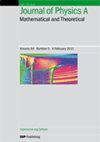Decoherence of a charged Brownian particle in a magnetic field: an analysis of the roles of coupling via position and momentum variables
IF 2.1
3区 物理与天体物理
Q2 PHYSICS, MATHEMATICAL
Journal of Physics A: Mathematical and Theoretical
Pub Date : 2024-08-28
DOI:10.1088/1751-8121/ad707e
引用次数: 0
Abstract
The study of decoherence plays a key role in our understanding of the transition from the quantum to the classical world. Typically, one considers a system coupled to an external bath which forms a model for an open quantum system. While most of the studies pertain to a position coupling between the system and the environment, some involve a momentum coupling, giving rise to an anomalous diffusive model. Here we have gone beyond existing studies and analyzed the non-Markovian master equation, involving the quantum Langevin dynamics of a harmonically oscillating charged Brownian particle in the presence of a magnetic field and coupled to Ohmic (带电布朗粒子在磁场中的退相干:位置和动量变量耦合作用分析
退相干研究在我们理解从量子世界到经典世界的转变过程中起着关键作用。通常,我们会考虑一个与外部浴场耦合的系统,它构成了一个开放量子系统的模型。虽然大多数研究涉及系统与环境之间的位置耦合,但有些研究涉及动量耦合,从而产生了反常扩散模型。在这里,我们超越了现有的研究,分析了非马尔可夫主方程,其中涉及一个谐振带电布朗粒子在磁场存在下的量子朗文动力学,并通过位置和动量耦合与欧姆(s = 1)、亚欧姆(s < 1)和超欧姆(s > 1)热浴耦合。位置耦合和动量耦合的存在会导致与环境更强的相互作用,从而使相干性的丧失速度快于仅存在位置耦合的情况。退相干的速度可以通过控制位置和动量耦合参数的相对强度来调节。此外,无论系统与浴槽之间的耦合性质如何,磁场都会导致系统信息丢失速度减慢。欧姆参数's'值越高,退相干速率越快。我们的结果可以通过设计合适的离子阱装置进行实验验证。
本文章由计算机程序翻译,如有差异,请以英文原文为准。
求助全文
约1分钟内获得全文
求助全文
来源期刊
CiteScore
4.10
自引率
14.30%
发文量
542
审稿时长
1.9 months
期刊介绍:
Publishing 50 issues a year, Journal of Physics A: Mathematical and Theoretical is a major journal of theoretical physics reporting research on the mathematical structures that describe fundamental processes of the physical world and on the analytical, computational and numerical methods for exploring these structures.

 求助内容:
求助内容: 应助结果提醒方式:
应助结果提醒方式:


